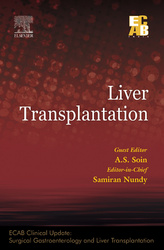「重要なお知らせ:日本語書籍をご購入いただき、eLibraryをご利用の皆さまへ」
エルゼビアは、より快適にサービスをご利用いただくため、システムの重要なアップデートを実施いたします。
現在、新サイト、eBooks+への移行が進められています。
新規ユーザー登録および書籍の登録はElsevier eLibraryでは停止しております。
12月15日以降に
こちらよりご利用・ご登録ください。
Book Description
Liver Transplantation (LT), until recently the ‘forbidden fruit’, is the newest, the sexiest, the most controversial and arguably, the most technically challenging subspecialty of Surgical Gastroenterology to have mushroomed in India. In a journey spanning 12 years, 28 centers and 1500 liver transplants, we imagined there would be a gripping story to tell. It was only appropriate then, that we chose to inaugurate the series with an overview of Liver Transplantation. In the last 2 decades, the field has seen rapid progress with 1- and 5-year patient survival improving from 80% and 50% to 90% and 80%, respectively, owing to technical refinement, and better immunosuppressants, intensive care, and patient monitoring. Despite being a relatively new entrant into the field, India can now boast of at least some islands of excellence that have caught up with the "best in the west". This means the evolution of LT in these centers has been fast-forwarded up a steep curve. We have come a long way from the point of every LT being considered an experimental procedure with much media and public hype to one where it is accepted as a successful and durable panacea for all liver failure. The popularity of teams running successful programs in India has swung from being ostracized when the chips were down, to being celebrated and envied when the going became good. The focus has shifted from immediate to long-term survival, from surgical heroism to building multidisciplinary teams, from anecdotal to hard data and from media reports to scientific publications. ‘Fly-by night’ operations are on the decline as realization of their futility dawns on new centers and transplant teams. They are now happier to take the longer route of developing trained in-house teams. After spending a good part of the last decade honing the technique of living donor liver transplantation, we are becoming more sensitive to the morbidity and mortality risks to the living liver donor. We want to minimize the liver volume removed from the donor, and want to develop techniques of minimal access. More importantly, we want to train our guns back on pushing donation after brain or cardiac death. We have begun to maintain databases, are getting into audit mode and want a National registry. We want standardized treatment guidelines and training curricula. We want to take part in multicenter trials and further meaningful clinical and laboratory research. As a community, the liver transplant doctors of India are on a warpath of progress. We want it all and we want it now! The first step to the march into the future is to size up the past and the present. That is what we have attempted to do in this volume.


 (0 rating)
(0 rating) 




